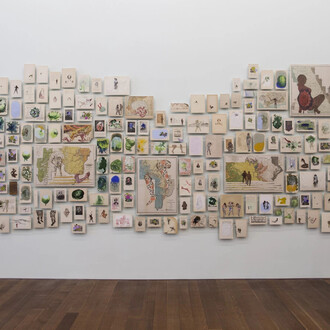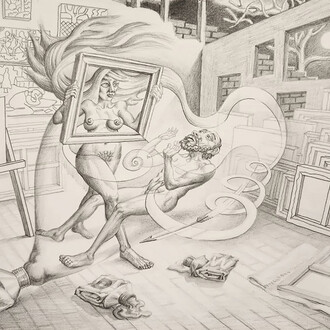Empty chairs hanging off the side of a government building, stacks of neatly folded shirts punctured by a steel bar, an armoire filled with concrete, a 40-foot blanket of rose petals sewn together by hand. These works are part of the first retrospective of renowned Colombian sculptor Doris Salcedo at the Museum of Contemporary Art Chicago from February 21 to May 24, 2015. The exhibition brings together works from all of Salcedo’s major bodies of work spanning her 30-year career and features the US debut of her major work Plegaria Muda (2008-10). Doris Salcedo is co-curated by MCA Pritzker Director Madeleine Grynsztejn and MCA Curator Julie Rodrigues Widholm.
Doris Salcedo’s site-specific projects and sculptures, elegantly shaped from commonplace materials, reveal her engagement with the question of how art can confront political violence in the modern world. Drawing on extensive conversations with witnesses and survivors, Salcedo insists on bringing past losses and ghostly absences into palpable form. The exhibition provides fresh insight into Salcedo’s methods, from her formal craft and innovations as an artist, to the ways in which her work addresses both individual loss and systemic oppression. Her work asks viewers not merely to remember but also to resist forgetting.
Salcedo’s work is grounded in rigorous fieldwork, including testimonies from victims who have suffered loss and trauma due to war and other unjust circumstances. It is deeply rooted in her country of Colombia’s social and political landscape, including its long history of civil conflicts, yet her sculptures and installations subtly address these fraught circumstances with elegance and a poetic sensibility that balances the gravitas of her subjects. Her works—often made of everyday materials such as furniture, clothing, and other vernacular objects—suggest avenues for a collective mourning which, in the artist’s words, “attempts to give back the sense, meaning, and form that violence took away from its victims.”
The exhibition begins with a selection of Salcedo’s earliest works made of found hospital furniture and stacks of white cotton shirts impaled by steel rebar. She re-creates the original installation of these works as they were first shown in Bogotá in 1990. The largest group of sculptures from her longest-running body of work (which she made between 1989 and 2008)-- works made from armoires, chairs, beds, and other pieces of furniture that have been filled with concrete and, at times, fused together and embedded with clothing—are arranged in-situ by the artist.
Other major installations include La Casa Viuda (1993-95), a group of sculptures that address the experiences of dislocated widows and is made primarily from found doors removed from their architectural foundations; Unland (1995–98), a series of three works that each combine parts of dissimilar tables that are seemingly sewn together by human hair and raw silk; Atrabiliarios (1992-2004), which encases abandoned shoes within the gallery walls behind a translucent surface that has been sewn into the wall; the aforementioned Plegaria Muda, an expansive installation of sculptures involving tables inverted one atop another, with individual blades of grass growing through holes in their surfaces; and A Flor de Piel (2014), an enormous, shroud-like sculpture made entirely of treated rose petals sutured together by hand, which drapes across the floor of the gallery.
The exhibition also debuts the artist’s newest body of work, Disremembered (2014)—tunic-like sculptures sewn entirely out of raw silk, the threads connected through the use of nearly 12,000 needles. As these works evidence, Salcedo’s artworks convey a sense of an absent, missing body and evoke a collective sense of loss rather than creating literal depictions of war’s effects. The resulting pieces engage with multiple dualities at once—strength and fragility, the ephemeral and the enduring—and bear elements of healing and 3 reparation in the careful, laborious process of their making.
In the past fifteen years, Salcedo has also created a number of large-scale, site-specific installations around the world, including Turkey, Italy, England, and her native Colombia. Included within the exhibition, the MCA is producing a short documentary on Salcedo’s site-specific and public installations, works that either no longer exist or are otherwise impossible to display in the galleries of the museum. This includes works such as Noviembre 6 y 7 (2002), an outdoor, installation at the Palace of Justice, and Acción de Duelo (2007), an intervention in the Plaza de Bolívar, both in Bogotá. In Untitled, commissioned for the 8th Istanbul Biennial (2003), Salcedo composed a massive public work out of some 1,550 chairs stacked between two buildings in an empty lot. For Shibboleth (2007), her major, commissioned project for the Turbine Hall at Tate Modern, London, Salcedo created a crack in the concrete floor running the length of the massive Hall as a meditation on immigration and racism.
Doris Salcedo was born in 1958 in Bogotá where she continues to live and work. Salcedo earned a BFA at Universidad de Bogotá Jorge Tadeo Lozano (1980) and an MA from New York University (1984). Recognized since the early 1990s as one of the leading sculptors of her generation, her work has been included in numerous exhibitions such as the Carnegie International 1995, Carnegie Museum, Pittsburgh; Roteiros, XXIV Bienal de São Paulo, Brazil (1998); Trace, the Liverpool Biennial of Contemporary Art (1999); Documenta 11, Kassel (2002); the 8th International Istanbul Biennial (2003); the T1Triennial for Contemporary Art, Castello de Rivoli, Turin (2005); and was invited to produce a major installation for the Turbine Hall at Tate Modern, London in 2007, which resulted in her highly charged work Shibboleth. From 2010-13, the artist’s major installation, Plegaria Muda, traveled to museums in Mexico, Brazil, Italy, Portugal, Sweden, and Japan. Her awards include the 9th Hiroshima Art Prize (2014); the Ordway Prize from the Penny McCall Foundation (2005); and a Solomon R. Guggenheim Foundation Grant (1995).



















